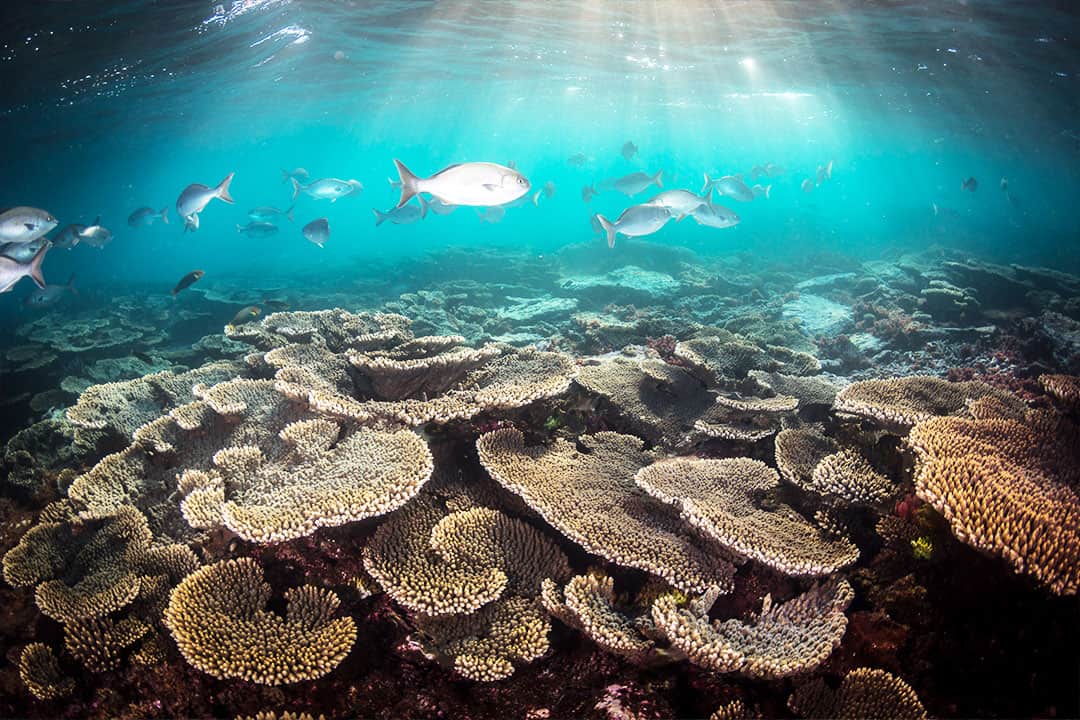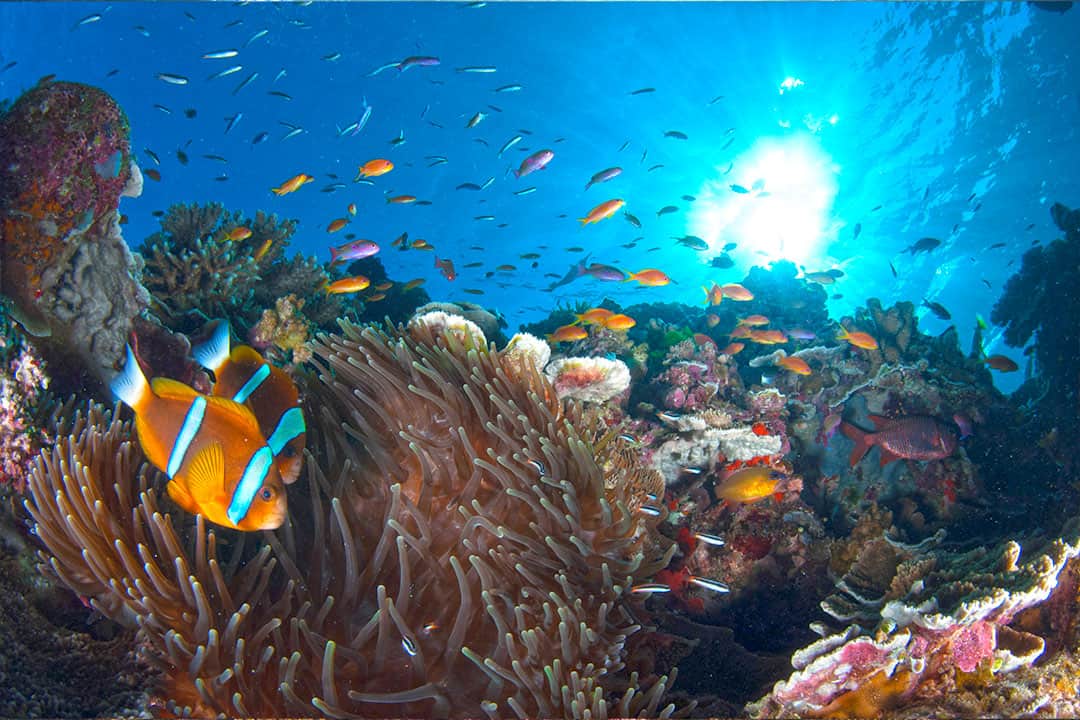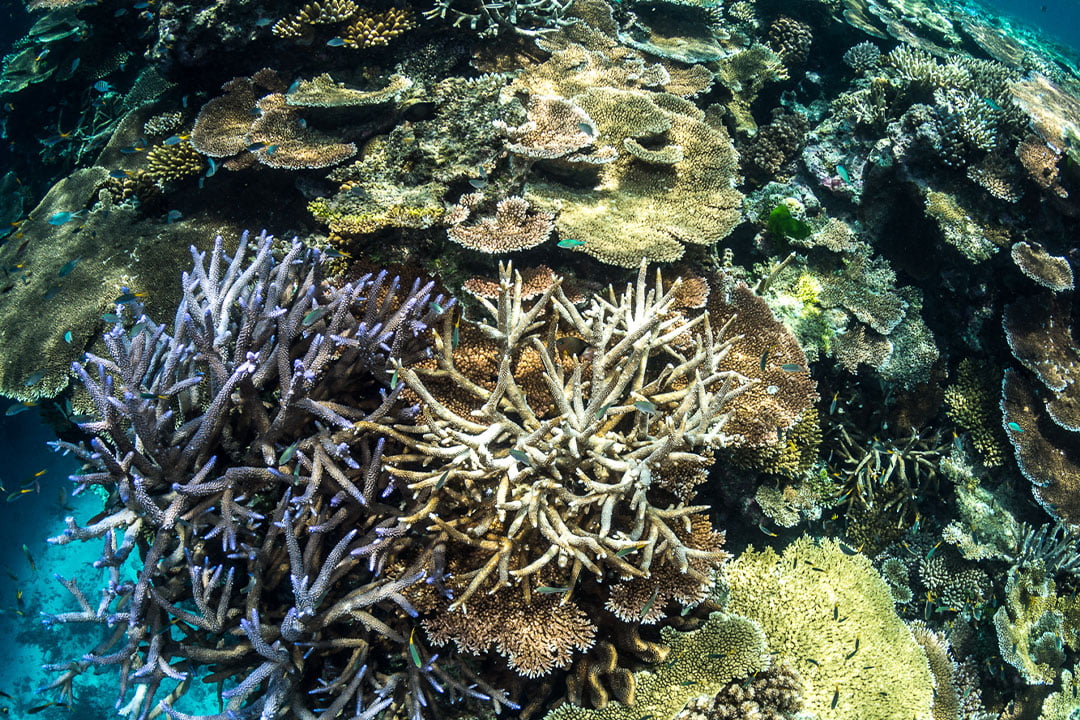Wildlife Of The Great Barrier Reef
© Official Local Whitsundays Website
Have you ever wondered what it would be like to explore the depths of one of Earth’s natural wonders? The Great Barrier Reef Marine Park is home to a plethora of unique and fascinating wildlife, making exploration an incredible experience. From majestic sea turtles to vibrant coral reefs, there’s something for everyone in this vast aquatic world. In this article, we’ll take you on a journey through the diverse range of creatures that inhabit the Great Barrier Reef and why they’re so important to our planet.
The Great Barrier Reef Marine Park stretches over 344,000 square kilometres off Australia’s eastern coast, making it the largest living structure on Earth! It also holds immense biodiversity – with more than 1,500 species of fish, 600 types of hard corals and 30 species of whales and dolphins found within its boundaries. The region is also home to spectacular marine mammals such as dugongs and sea turtles, as well as numerous bird species including seabirds, shorebirds and migratory waterfowl. This abundance of life means that the park provides critical habitat for much-needed conservation efforts worldwide.
Not only does the Great Barrier Reef provide essential habitats for various wildlife – it also offers unparalleled opportunities for diving and snorkelling activities! With crystal clear waters teeming with colourful coral gardens and exotic fish varieties, visitors can immerse themselves in nature at its finest. Whether you’re looking for adventure or relaxation – the reef has something special waiting right around every corner!

Marine Wildlife
The Great Barrier Reef is teeming with wildlife. It’s home to over 1500 species of fish, plus numerous types of coral, invertebrates and sponges. All these marine creatures have their own unique adaptations that help them survive in the harsh environment of the reef.
Turtles are a particularly iconic symbol of the GBRMP and can be spotted swimming gracefully through its waters. They feed on seagrass beds and jellyfish, while avoiding predators like sharks and barracudas. The Green Turtle is one of six different turtle species found here; it’s also listed as endangered due to human-caused threats such as illegal poaching, plastic pollution, oil spills and climate change.
Whale sharks often cruise past too; this gentle giant feeds mainly on plankton so poses no threat to humans despite its size! With so many incredible animals roaming the area, you’re sure to see something amazing if you take a dive into the Great Barrier Reef Marine Park.
Below are the more famous 25 marine creatures in the marine park
- Clownfish
- Green sea turtle
- Giant clam
- Hammerhead shark
- Maori wrasse
- Humpback whale
- Blue spotted ray
- Manta ray
- Octopus
- Moray eel
- Parrotfish
- Seahorse
- Dugong
- Starfish
- Triggerfish
- Anemone
- Lionfish
- Barramundi cod
- Blacktip reef shark
- Jellyfish
- Sea snake
- Nudibranch
- Cuttlefish
- Coral trout
- Fusilier fish
Below are a few of my farourites explained in depth
Manta rays
Manta rays are the most enchanting wildlife of the Great Barrier Reef, their majestic wingspan captivating onlookers. These wondrous creatures evoke a sense of freedom and often draw out an emotional reaction from visitors to the park.
Characterized by long whip-like tails with barbs at the end, manta rays can grow up to 7 meters wide and weigh several hundred kilograms. Though they may seem intimidating due to their size, these graceful giants are not known for being aggressive towards humans–they much prefer dining on crustaceans such as shrimp or crabs! Mantarays migrate seasonally throughout the marine park, although it’s still unknown why exactly they do so; however, locals believe that mating is likely one factor influencing this behaviour.
Due to their migratory habits, manta ray encounters are unpredictable but highly sought after experiences within the reef. The best time of year to view them appears to be between May and September – when the ocean waters are warmest – which makes summertime a great time for tourists hoping to catch a glimpse of these awe-inspiring creatures.

Turtles
The Great Barrier Reef Marine Park is home to an array of fascinating species. Following the majestic mantarays, we now turn our attention to turtles – another wonderful part of this incredible ecosystem.
Turtles are a crucial part of the marine life found within the reef and have been swimming its waters for millions of years. There are six different species living here: flatback, green, hawksbill, leatherback, loggerhead and olive ridley turtles. All but one – the flatback turtle – can be spotted in other parts of Australia too.
These gentle creatures offer us a rare opportunity to observe them as they glide through their natural habitat with grace and elegance. It’s not uncommon for lucky visitors to see huge groups gathering at certain times of year near feeding grounds or nesting sites; events like these help connect people with nature and inspire awe-filled appreciation for wildlife conservation efforts.
We must continue to protect these unique animals so future generations may enjoy encounters just as special as those experienced today! With luck, everyone will benefit from maintaining healthy ecosystems that support thriving populations of turtles in the Great Barrier Reef Marine Park.
Reef Sharks
It’s ironic that the Great Barrier Reef Marine Park is renowned for its teeming population of marine life, yet one of its most feared inhabitants are sharks. But despite their reputation, reef sharks actually play an important role in the park’s ecosystem and deserve our respect.
Here’s why:
– They’re apex predators who help maintain a balance between prey species populations and resources like food, shelter and space.
– This prevents any one species from dominating or taking over a particular habitat.
– It also helps keep nutrients cycling through the environment so other organisms can benefit too.
Reef sharks have been around since prehistoric times and they’ve evolved to be incredibly well adapted to life on coral reefs. They rely on camouflage to blend into their surroundings, making them difficult to spot even when you know where to look – so it pays to be extra vigilant!
Their ability to survive in such harsh conditions makes them resilient; however, they face many threats including pollution, fishing pressures, loss of habitat due to climate change and illegal hunting. All these factors make it essential that we do all we can to protect this unique animal before it’s too late. We must ensure that reef sharks remain part of the incredible wildlife of the Great Barrier Reef for generations to come.

Coral Life
Wildlife of the Great Barrier Reef Marine Park calls the vast amount of coral home. From the colourful hard corals like the brain, star and staghorn varieties, to the soft corals like sea fans and whip coral; there are many species found here in abundance. Many different kinds of fish, crustaceans and other invertebrate animals make their homes amongst these diverse habitats as well. A truly unique experience can be gained by diving or snorkelling through this magnificent underwater world.
Observing the intricate structures of each type of coral is mesmerizing, with vibrant colours that contrast against the deep blue background of the ocean’s depths. This visual feast can be enjoyed while swimming among them, without disturbing nature’s delicate balance. The sheer variety and a number of creatures living within these ecosystems create an incredible spectacle for visitors to observe first-hand.
It has never been more important to appreciate our planet’s natural beauty than it is now – a reminder that we must protect our oceans from further destruction and work with our Indgious culture leaders of the park if we want future generations to enjoy its wonders too. Therefore, visiting such areas and understanding what lies beneath should inspire us all towards making conscious decisions about how we interact with marine life going forward.
List of types of Coral on the Great Barrier Reef
- Brain coral
- Staghorn coral
- Table coral
- Finger coral
- Mushroom coral
- Plate coral
- Boulder coral
- Porous coral
- Honeycomb coral
- Pencil coral
- Branching coral
- Bubble coral
- Fused-staghorn coral
- Maze coral
- Lettuce coral
- Thin-leaf coral
- Ridge coral
- Blushing star coral
- Mustard hill coral
- Cabbage coral
Wildlife In The Great Barrier Reef Frequently Asked Questions (FAQ)
How Can I Safely View The Wildlife Of The Great Barrier Reef Marine Park?
Seeing its wildlife can be an incredible, life-changing experience. But how can you safely view it? Here’s what you need to know.
Firstly, don’t go diving or snorkelling in areas where there are strong currents or rips. These places may appear calm on the surface, but underneath they can be extremely dangerous for inexperienced swimmers and divers. Instead, stick to areas that have been reviewed and approved by safety authorities – this will ensure your safety as well as protect marine life from potential harm.
Next, make sure you’re familiar with basic guidelines for interacting with marine animals before entering their habitat. This means keeping a safe distance away so as not to disturb them; never feeding wild animals; wearing sunscreen that won’t damage coral reefs; disposing of all rubbish properly; and always respecting signs warning visitors about dangers such as jellyfish or potentially hazardous sea creatures like stingrays or sharks.
Finally, if you want to get up close and personal with some of the park’s unique creatures then consider taking a guided tour with experienced guides who know how best to interact with wildlife without causing any harm. That way, you’ll get the most out of your visit while helping to preserve one of Australia’s greatest natural wonders!
What Effect Does Pollution Have On The Wildlife
The Great Barrier Reef Marine Park is one of the most beautiful places on earth, but sadly it faces an increasing threat from pollution. Pollution has had a devastating effect on the wildlife that inhabit this fragile ecosystem and its effects can be seen in everything from coral bleaching to the decline in certain species populations. Here are three ways that pollution affects the wildlife of the Great Barrier Reef Marine Park:
Firstly, there is water contamination caused by runoff from urban areas or agricultural land. This can affect marine life directly as they ingest toxic chemicals through their food sources or become entangled in plastic debris. Furthermore, contaminated water can reduce light penetration into deeper reef habitats, starving out photosynthetic organisms such as corals and seagrass beds which form important nurseries for fish and other sea creatures.
Secondly, air pollution resulting from industrial activity around coastal areas causes acid rain which lands directly onto delicate ecosystems like coral reefs. The acidic waters eat away at the calcium carbonate structure of many species’ skeletons causing them to become weakened and die off over time. On top of this, increased sedimentation due to construction along coastlines further smothers these plants and animals wiping out entire communities of unique species found nowhere else on Earth.
Finally, climate change is another major factor when considering the effects of pollution on wildlife at the Great Barrier Reef Marine Park. Ocean temperatures have risen significantly in recent years due to human activities such as burning fossil fuels and releasing greenhouse gases into the atmosphere; this increases ocean acidity levels while also allowing invasive species more opportunity to colonize vulnerable environments putting native flora and fauna under greater pressure than ever before.
It’s clear that something must be done soon if we want our children to enjoy all that nature has provided us with at this incredible park. Through better management practices, stricter regulations governing industry and agriculture near coastal areas, as well as individuals reducing their own personal contributions to global warming through lifestyle changes – we can ensure that future generations will still get to experience the breathtaking beauty of this natural wonderland for years to come!
How Can I Help Protect The Wildlife?
We all know the importance of protecting our environment and its wildlife, but how can we make a difference for the animals that call the Great Barrier Reef Marine Park home? There are numerous ways to help protect them from destruction or endangerment.
First, by simply educating oneself on what species exist in the park and what their needs are. With this knowledge, one can then take actionable steps such as:
* Donating money to conservation organizations dedicated to preserving the area
* Volunteering time at local events such as beach cleanups or reef monitoring programs
* Supporting policies that promote sustainability practices in nearby communities
* Participating in public campaigns that focus on raising awareness about marine life protection efforts
Taking part in activities like these will ensure that future generations have an opportunity to witness these magnificent creatures living happily in their natural habitats. It’s also important to remember that small changes made now can lead to big results later – even something as simple as reducing plastic waste consumption can go a long way!
The best thing anyone can do is be proactive when it comes to protecting wildlife habitats. By taking actions into our own hands, together we can create a brighter future for ourselves and those creatures who depend on us for survival.
Are There Any Endangered Species In The Great Barrier Reef Marine Park?
This is a crucial question to consider, as this unique ecosystem is home to numerous animals and plants that are at risk of disappearing forever. The answer may surprise you: yes, many species living within the park’s boundaries are threatened or endangered due to factors like overfishing, pollution, habitat destruction and climate change.
The list of endangered wildlife includes iconic creatures such as dugongs, sea turtles and giant clams. These majestic species have been around for millions of years but now they face an uncertain future because of human activities. Dugong numbers have plummeted due to commercial fishing operations while sea turtles suffer from entanglement in plastic debris and other pollutants. Additionally, coral bleaching caused by rising temperatures has decimated entire colonies of these ancient invertebrates.
We must take action if we want to protect these vulnerable populations from extinction. Conservation efforts should focus on reducing ocean pollution and creating more sustainable fisheries practices. Governments can also implement policies that help reduce emissions and protect habitats from development projects. In addition, educating people about why it’s important to safeguard these incredible ecosystems will go a long way towards ensuring their survival for generations to come.
It’s our responsibility – both collectively and individually – to do whatever we can to preserve these amazing marine creatures before they become lost forever. With the right approach, we can make sure that the Great Barrier Reef remains one of nature’s greatest wonders for many years to come.
[forminator_form id=”244492″]
Hi, I’m Nath J, a long-time local who’s been lucky enough to live and work tourism in the Whitsundays since 2001.
Over the past two decades, I’ve helped visitors discover the best of this incredible region, from Whitehaven Beach and Hill Inlet to the hidden spots only locals know about. I started out managing boats and tours, and these days I run Ripple Effect Online, a tourism-focused digital marketing business helping local operators grow and connect with travellers like you.
I’ve written an ebook called Whitsunday Islands: A Journey through Paradise, created countless local travel guides, and earned recognition as a “Whitsundays Tourism Hero” from QTIC for my contribution to the region and gained First Nations Cultural Protocol training through QTIC as well. But more importantly, I’ve spent years listening to travellers, understanding what makes a trip unforgettable, and helping people plan the kind of experience they’ll talk about for years.
If you’re planning a visit to Whitehaven Beach or anywhere in the Whitsundays, I’m here to help you make it amazing.
Find me on Facebook and LinkedIn or drop me an email at info@nath-j.au.
